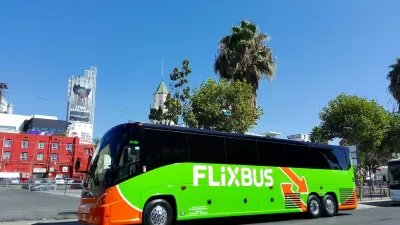The terminal, sold last year, is the only intercity bus station in the city, serving hundreds of thousands of mostly low-income travelers each year.

The only intercity bus terminal in Chicago, formerly belonging to Greyhound, could close as a result of the company’s acquisition by FlixMobility. Dan Zukowski outlines the story in Smart Cities Dive, noting that “All but two of Greyhound’s former properties were sold by September 2022, causing cities to lose enclosed bus stations and forcing riders to wait at curbside or other locations lacking waiting rooms and other amenities.”
According to a brief from the Chaddick Institute for Metropolitan Development at DePaul University, “Allowing the closure of the Greyhound Station without giving passengers an attractive alternative that is both centrally located and equipped with an indoor waiting room would make metropolitan Chicago a weak link in the national intercity bus system.” The station currently serves between 456,000 and 557,000 riders per year, according to a Chaddick estimate, with almost 400,000 more riders using curbside pickup locations, which lack protection from winter weather and heat, for Greyhound and other bus lines.
The brief calls on the city to take over operations of the bus station and keep it in service for the passengers who rely on it and explore options for expanding intercity bus service to and from Chicago.
FULL STORY: Chicago may lose its only intercity bus station, placing burden on disadvantaged travelers

Study: Maui’s Plan to Convert Vacation Rentals to Long-Term Housing Could Cause Nearly $1 Billion Economic Loss
The plan would reduce visitor accommodation by 25,% resulting in 1,900 jobs lost.

North Texas Transit Leaders Tout Benefits of TOD for Growing Region
At a summit focused on transit-oriented development, policymakers discussed how North Texas’ expanded light rail system can serve as a tool for economic growth.

Why Should We Subsidize Public Transportation?
Many public transit agencies face financial stress due to rising costs, declining fare revenue, and declining subsidies. Transit advocates must provide a strong business case for increasing public transit funding.

How to Make US Trains Faster
Changes to boarding platforms and a switch to electric trains could improve U.S. passenger rail service without the added cost of high-speed rail.

Columbia’s Revitalized ‘Loop’ Is a Hub for Local Entrepreneurs
A focus on small businesses is helping a commercial corridor in Columbia, Missouri thrive.

Invasive Insect Threatens Minnesota’s Ash Forests
The Emerald Ash Borer is a rapidly spreading invasive pest threatening Minnesota’s ash trees, and homeowners are encouraged to plant diverse replacement species, avoid moving ash firewood, and monitor for signs of infestation.
Urban Design for Planners 1: Software Tools
This six-course series explores essential urban design concepts using open source software and equips planners with the tools they need to participate fully in the urban design process.
Planning for Universal Design
Learn the tools for implementing Universal Design in planning regulations.
City of Santa Clarita
Ascent Environmental
Institute for Housing and Urban Development Studies (IHS)
City of Grandview
Harvard GSD Executive Education
Toledo-Lucas County Plan Commissions
Salt Lake City
NYU Wagner Graduate School of Public Service





























